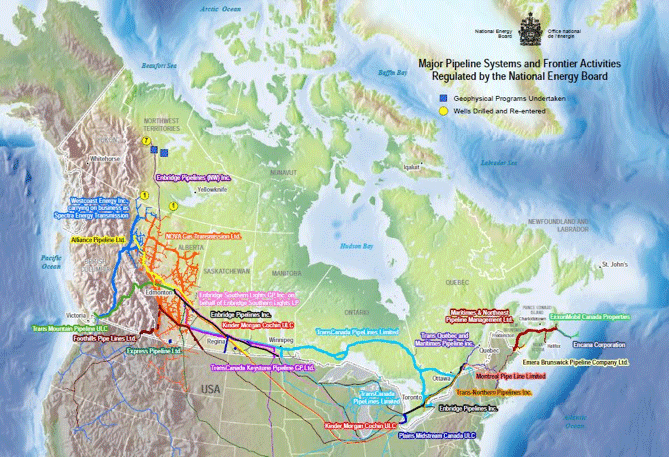Canada's Energy Transportation System
Energy is a key contributor to Canada’s economy. In 2016, the energy sector was responsible for 884,000 jobs or nearly 5% of total Canadian employment. The energy sector also drove $187 billion or nearly 10% of nominal Gross Domestic Product (GDP). In addition, energy accounts for a significant portion of Canadian trade, including $86 billion of exports in 2016 or roughly 18% of total Canadian merchandise exports.
884,000 Energy Sector Jobs in 2016
9.9% of Canada’s GDP or $187 Billion
Canada’s energy system is also integral to the broader economy, as it enables the production and delivery of goods and services, and is a key driver of research, development, and innovation. The energy system touches all aspects of our daily lives, from running our vehicles to heating our homes and powering our electronics.
The NEB regulates critical elements of Canada’s energy system, including 85 international power lines comprising 1,462 km. Most Canadian power lines fall within provincial jurisdiction because roughly 90% of the electricity produced in Canada is consumed domestically. However, international demand for Canadian power – which is mostly generated from renewable sources – is expected to increase in coming years. If so, the NEB’s regulatory role in electricity will also increase.
-
 Canadian non-hydro renewables (solar, wind, and biomass):
Canadian non-hydro renewables (solar, wind, and biomass):
2005: 2% of total power capacity
2016: 12% of total power capacity

The NEB regulates 72,126 km of pipelines, or roughly 10% of the total length of pipelines in Canada. If a pipeline system crosses provincial or international boundaries, it is regulated by the NEB. If a pipeline system is contained within a province, it is generally under the jurisdiction of a provincial regulator (e.g. pipelines located solely in British Columbia are regulated by the BC Oil and Gas Commission; those in Quebec are regulated by a number of provincial entities, including the Régie de l’energie du Québec.)
NEB-regulated pipelines transport about 45 petajoules of petroleum products per day.
Canada is the sixth largest producer of oil in the world, accounting for nearly 5% of total global supply. We are also the fifth largest producer of natural gas in the world, producing more than 4% of global supply.
-
 Canadian crude oil production in 2017: >4 million barrels per day.
Canadian crude oil production in 2017: >4 million barrels per day. -
 Canadian natural gas production in 2017: >15 billion cubic feet per day.
Canadian natural gas production in 2017: >15 billion cubic feet per day.
The majority of this was transported by NEB-regulated pipelines from production areas in Western Canada to consumers elsewhere in Canada or the United States.

Low commodity prices have significantly changed the economics of the energy sector since 2014, but NEB-regulated pipelines continued transporting roughly $100 billion of energy products during each of the last few years.
On a longer time horizon, future pipeline utilization and investment will be influenced by any sustained trends in energy supply, demand, and pricing. These will in turn be affected by factors such as technology, consumer preferences, and public policy. Developments in Canada’s electricity sector, which has been trending away from coal toward increased generation from natural gas and non-hydro renewables, will also play a key role.

